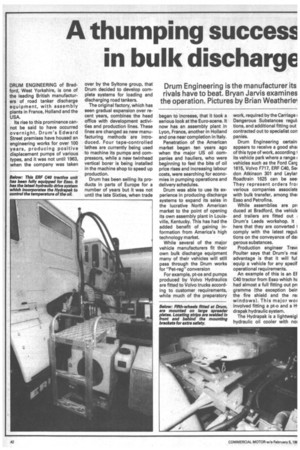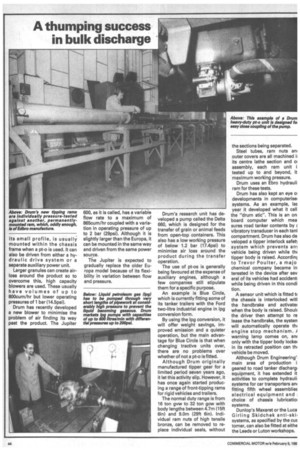A thumping success in bulk discharge
Page 44

Page 45

Page 46

If you've noticed an error in this article please click here to report it so we can fix it.
Drum Engineering is the manufacturer its rivals have to beat. Bryan Jarvis examines the operation. Pictures by Brian Weatherlel
DRUM ENGINEERING of Bradford, West Yorkshire, is one of the leading British manufacturers of road tanker discharge equipment, with assembly plants in France, Holland and the USA.
Its rise to this prominence cannot be said to have occurred overnight. Drum's Edward Street premises have housed an engineering works for over 100 years, producing positive displacement pumps of various types, and it was not until 1963, when the company was taken over by the Sy!tone group, that Drum decided to develop complete systems for loading and discharging road tankers.
The original factory, which has seen gradual expansion over recent years, combines the head office with development activities and production lines. These lines are changed as new manufacturing methods are introduced. Four tape-controlled lathes are currently being used to machine its pumps and compressors, while a new twinhead vertical borer is being installed in the machine shop to speed up production.
Drum has been selling its products in parts of Europe for a number of years but it was not until the late Sixties, when trade began to increase, that it took a serious look at the Euro-scene. It now has an assembly plant in Lyon, France, another in Holland and one near completion in Italy.
Penetration of the American market began ten years ago when the major US oil companies and hauliers, who were beginning to feel the bite of oil price rises and increasing labour costs, were searching for economies in pumping operations and delivery schedules.
Drum was able to use its experience in producing discharge systems to expand its sales in the lucrative North American market to the point of opening its own assembly plant in Louisville, Kentucky. This has had the added benefit of gaining information from America's high technology market.
While several of the major vehicle manufacturers fit their own bulk discharge equipment many of their vehicles will still pass through the Drum works for "Pet-reg" conversion For example, pt-os and pumps produced by Volvo Hydraulics are fitted to Volvo trucks according to customer requirements, while much of the preparatory work, required by the Carriage I Dangerous Substances regull tions, and additional fitting out contracted out to specialist con 'Denies.
Drum Engineering certain appears to receive a good shai of this type of work, according 1 its vehicle park where a range vehicles such as the Ford Carg 1615, Volvo F717, ERF C40, Sei don Atkinson 301 and Leylan Roadtrain 1625 can be see' Ttiey represent orders froi various companies associate with bulk transfer, among thei Esso and Petrofina.
While assemblies are prr duced at Bradford, the vehicIE and trailers are fitted out Drum's Leeds workshop. It here that they are converted 1 comply with the latest reguL tions on the conveyance of dai gerous substances.
Production engineer Trey( Poulter says that Drum's mai advantage is that it will full equip a vehicle for any specif operational requirements.
An example of this is an EF C40 tractor from Esso which hg had almost a full fitting out ors gramme (the exception bein the fire shield and the rag windows). This major wor involved fitting a pt-o and a drapak hydraulic system.
The Hydrapak is a lightweigl hydraulic oil cooler with noi spill couplings, which is bolted to the chassis frame and on this particular vehicle, is protected by the catwalk, mounted above it.
The Hydrapak weighs only 29kg (641b) and is the result of two years of development at Drum. Its thermostatically controlled fan warms the oil rapidly and controls the cooling rate to prevent over-cooling of, the oil.
The main advantage in using the Hydrapak hydraulic system is that it allows the pump to be mounted immediately below the tank outlet on rear outlet, rigid and articulated tankers.
By mounting the discharge equipment on the semi-trailer, the tractor becomes a standard power source, thus allowing operators of mixed artic-tanker fleets to interchange tractive units. This also includes redeployment with tipping trailers.
To tie in with the Hydrapak hydraulic system, Drum has developed a cradle unit for tanker discharge systems, which attaches below the tanker chassis and holds the pump in place. The advantage is that by disconnecting its mounting bolts, the entire pump installation can be removed and transferred to another tanker.
The lubricating oils which are transported in bulk have differing viscous properties, and where deliveries are fed through straight hose systems the pump can generally be driven at a higher speed than when the product is fed through a meter and hose system with its accompanying back pressures.
Drum's Mercury 3 and Pluto pumps are designed to handle a wide range of lubricating oils from kerosene to black oil. To reduce the effect of shock pressures both types are fitted with two-stage relief valves.
Back pressures can also be accompanied by aeration of the product from the excessive agitation caused when trigger-type , valves are closed after delivery, and to overcome this Drum has produced its Maxiflow system. n
This is designed to ensure that when the trigger nozzle is closed and the pump goes onto bypass, the pressure in the pump is reduced to 1 bar (14.5psi). This should also prevent meter and hose damage.
Some liquids are nigh on impossible to pump because of their extremely high viscosity. One of the more difficult commodities to transport in bulk is molasses, for which a hydraulically-driven pump is normally used to minimise the length of pipework.
Drum's Saturn 4 pump is designed to discharge molasses as well as glucose or liquid sugar. It has a capacity range of 1,020Itr/min at 750rpm down to 750Itr/min at 200rpm when the product is particularly viscous.
Dry bulk materials, such as powders or granules which are normally discharged under pressure, are catered for by Drum's Europa 400RB compressor, which can discharge up to 525cum/hr with pressures of up to 2 bar I29psi).
This compressor, because of
its small profile, is usually mounted within the chassis frame when a pt-o is used. It can also be driven from either a hydraulic drive system or a separate auxiliary power unit.
Larger granules can create airloss around the product so to overcome this, high capacity blowers are used. These usually have volumes of up to 800cum/hr but lower operating pressures of 1 bar (14.5psi).
Drum has recently developed a new blower to minimise the problem of air finding its way past the product. The Jupiter 600, as it is called, has a variable flow rate to a maximum of 865cum/hr coupled with a variation in operating pressure of up to 2 bar (29psi). Although it is slightly larger than the Europa, it can be mounted in the same way and driven from the same power source.
The Jupiter is expected to gradually replace the older Europa model because of its flexibility in variation between flow and pressure. Drum's research unit has developed a pump called the Delta 660, which is designed for the transfer of grain or animal feeds from open-top containers. This also has a low working pressure of below 1.2 bar (17.4psi) to minimise air loss around the product during the transfer operation.
The use of pt-os is generally being favoured at the expense of auxiliary engines, although a few companies still stipulate them for a specific purpose.
An example is Blue Circle, which is currently fitting some of its tanker trailers with the Ford two-litre industrial engine in lpg conversion form.
By using the lpg conversion, it will offer weight savings, improved emission and a quieter operation, but the main advantage for Blue Circle is that when changing tractive units over, there are no problems over whether of not a pt-o is fitted.
Although Drum originally manufactured tipper gear for a limited period seven years ago, it let this activity slip. However, it has once again started producing a range of front-tipping rams for rigid vehicles and trailers.
The normal duty range is from 16 ton gvw to 32 ton gcw with body lengths between 4.7m (15ft Gin) and 9.0m (29ft 6in). Individual ram nuts of high tensile bronze, can be removed to replace individual seals, without the sections being separated.
Steel tubes, ram nuts an outer covers are all machined ii its centre lathe section and 01 assembly, each ram unit i tested up to and beyond, it maximum working pressure.
Drum uses an Ebro hydrauli ram for these tests.
Drum has also kept an eye a developments in computerise' systems. As an example, las year it developed what it call the "drum stic". This is an on board computer which mea sures road tanker contents by vibratory transducer in each tanl compartment. Drum has also de veloped a tipper interlock safet) system which prevents an vehicle being driven while th( tipper body is raised. Accordinc to Trevor Poulter, a rnajo chemical company became in terested in the device after sev eral of its vehicles had accident; while being driven in this condi tion.
A sensor unit which is fitted t( the chassis is interlocked witl the handbrake and activate( when the body is raised. Shoul( the driver then attempt to re lease the handbrake, the systen will automatically operate thi engine stop mechanism. warning lamp comes on, an( only with the tipper body locke( in its retracted position can till vehicle be moved.
Although Drum Engineering'! main area of production i! geared to road tanker discharg, equipment, it has extended it activities to complete hydrauli, systems for car transporters ani fitting fifth wheel assemblies electrical equipment and choice of chassis lubricatioi systems.
Dunlop's Maxaret or the Luca Girling Skidchek anti-ski+ systems, as specified by the cus tomer, can also be fitted at eithe the Leeds or Luton workshops.












































































































